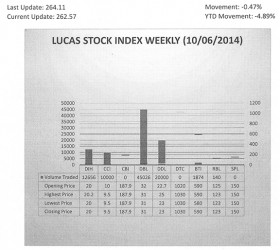Old ideas
GuyExpo might have presented new experiences for many Guyanese, but it also brought home the reality of the tragedy of the history of the country. The exhibition attracted foreign and local participation, but it also revealed that technology and initiatives which have been reported as breakthrough activities were in fact old ideas of the Burnham era that were once maligned by the PPP when it was in opposition. The ‘Rice Brekkies’ cereal which was highly touted by the government during the GuyExpo festival and reported in the Guyana Times as innovative is relying on locally produced rice as the principal ingredient for the production of the cereal. This idea of creating value-added economic activities in Guyana is no different from the initiative of the Burnham era which promoted the production of rice-based and other products with local content to help expand and diversify the economy of Guyana under its ‘Feed, Clothe and House’ the nation policy.
Rice initiative
This PPP-led government criticized that economic vision of Guyana when it was in opposition and undermined the national effort at enabling local producers of agricultural products to provide the foundation for economic growth and diversification. The rice initiative was wilfully taken out of context and presented as a personal affront to many supporters of the PPP since it was accompanied by the banning of wheat flour. Some writers on the Guyana economy even boast of how rice producers, who were largely PPP supporters, were encouraged to reduce rice production and did in order to undermine the initiative. This is similar to the destruction of sugar cane crops by supporters of the PPP to destroy the economic hopes of Guyana and increase its exposure to the vicissitudes of the global economy, the oil shocks and to powerful external forces during the 1970s. While that was happening, the world had already discovered the value of rice-based cereals as nutritional baby food and had begun to produce other rice-based products.
Principal idea
Today, rice flour, a principal idea of the Burnham era, is also regarded as more nutritional than wheat flour and is considered a darling of nutritionists. Twenty-two years after taking control of the reins of the Guyana economy, the PPP-led government has finally shown the courage to emulate the Burnham idea of achieving value-added economic activities using locally produced agricultural products, in this instance rice. The tragedy therefore of our history is that the government now tries to present this economic idea of Burnham as novel and as its own, even though rice cereal was once produced by a private company in Guyana and was consumed by Guyanese.
Restrain economic progress
The deceit contained in this disposition could be cited as one of the factors that helped to restrain the economic progress of the country. Political competition is one thing, but the reluctance to embrace economic opportunity and useful economic ideas despite its value and relevance is another. In an effort to introduce many  economic thoughts to Guyanese, the government of the Burnham era set up government-owned production facilities to demonstrate the technology and the economic utility of the value-added activities that it promoted. At that time, the novelty of the economic initiatives made that necessary, since both the technology and the markets for many products with local content were either new or still emerging across the world and in the laboratories of the Institute of Applied Science and Technology (IAST). During that period, Guyana produced many proven products with local agricultural content. These included ham and bacon, guava cheese, tomato ketchup, peanut butter, processed carambola for use in black cake, rice flour, coconut oil, and several traditional products such as plantain flour and corn flour. Government projects also included the production of canned pineapple and orange juice.
economic thoughts to Guyanese, the government of the Burnham era set up government-owned production facilities to demonstrate the technology and the economic utility of the value-added activities that it promoted. At that time, the novelty of the economic initiatives made that necessary, since both the technology and the markets for many products with local content were either new or still emerging across the world and in the laboratories of the Institute of Applied Science and Technology (IAST). During that period, Guyana produced many proven products with local agricultural content. These included ham and bacon, guava cheese, tomato ketchup, peanut butter, processed carambola for use in black cake, rice flour, coconut oil, and several traditional products such as plantain flour and corn flour. Government projects also included the production of canned pineapple and orange juice.
The economic philosophy of cooperative socialism which placed emphasis on local value-added production and envisaged critical inputs by the state did not provide sufficient economic space and incentive for local production to work. The attitude of the state was similar to that of the mercantilist philosophy which held the view that government investment was critical to achieving economic expansion and global political influence. Like the mercantilists, the idea too was to import fewer foreign processed products and to export more products that were manufactured by Guyanese. However, unlike the mercantilists who primarily used tariff barriers to decrease competition from imports, Guyana used the Raul Prebisch idea of import substitution which barred many products from entering the country and ended up shielding local producers from foreign competition altogether. These efforts were supported by the restrictions on the use and outflow of foreign currency. With private capital feeling stifled, the agro-processing efforts also led to the expansion of the government ownership of production facilities. Despite the economic relevance of agro-processing, the economic philosophy of cooperative socialism proved disastrous for Guyana. Admittedly, many would argue too that some of these structures served as symbols of opposition to colonial domination and local attempts at maintaining political control.
Puzzling
Guyana and the world have evolved beyond the point of political doubt. Guyana is operating in a more prosperous and a more accountable economic world where foreign markets are open to every country and economic opportunity abounds. In this environment, the economic value of agricultural-based products is well understood. Yet, the government cannot attract private investors to produce the rice cereal in an economy that is supposed to be already fully liberalized and dominated by private investment. Instead, the government finds it necessary to invest in a government-owned production facility. It is indeed puzzling as to why at this time the government has to adopt the ‘public goods’ and not the ‘private goods’ approach to this sensible economic venture. Equally puzzling too is why the public remains in the dark as to the reason that the opportunity was never given to private investors to get involved in producing a product that is already known to

The Lucas Stock Index (LSI) declined by 0.47 per cent in trading during the first period of October 2014. The stocks of six companies were traded with 89,696 shares changing hands. There was one Climber and three Tumblers. The value of the stocks of Demerara Distillers Limited (DDL) rose 1.32 per cent on the sale of 20,000. At the same time, the value of the stocks of Caribbean Container Incorporated (CCI) fell 5.00 per cent on the sale of 10,000 shares. The value of the shares of Demerara Bank Limited (DBL) fell 3.13 per cent on the sale of 45,026 shares while that of Republic Bank Limited (RBL) fell 1.60 per cent on the sale of 140 shares. In the meanwhile, the value of the shares of Banks DIH (DIH) and Guyana Bank for Trade and Industry (BTI) remained unchanged on the sale of 12,656 and 1,874 shares respectively.
consumers of this country. Further, the nation is being asked to blindly accept an economic decision for which a commercial feasibility study has not been seen.
Food campaign
The tragedy of our history might be excusable if it did not extend beyond the specific commodity of rice and went to the entire food campaign of the government. It is estimated that agriculture now contributes 19 per cent of the output of the country and about 22 per cent of the revenue earned by stakeholders of the sector. Whether under the slogan of ‘Eat What You Produce,’ ‘Buy Local,’ ‘Grow More Food’ or ‘Produce or Perish,’ the food campaign of the government also resembles the food campaign of the Burnham era. The purpose of the food campaign is also the same, ie, to increase the food security of Guyana and its economic diversification. Despite trying and calling for the establishment of mega-farms, the strategy of the government has ended up resembling that of the Burnham government too. The current agricultural drive of Guyana is relying on the growth of the non-traditional sector. Current government strategy has also been unable to escape its dependence on the small-scale and low-technology farmers. The interest in small farmers has suddenly arisen as a central theme in the food drive, and the ‘all hands on deck’ approach seems also to be creeping into the messages about food production by the government.
Caricom market
Further evidence of the inevitable but sorry reality of our history is the increasing recognition by the government of the value of the Caricom market to its agricultural efforts. Caricom was set up in 1973 by the Burnham and other Caribbean governments to expand economic production and trade among its members. The export of agricultural products to the region therefore was always a focus and emphasis of the Burnham government. This government has tried desperately to camouflage the relevance and importance of the Caricom market to Guyana and the role that the Burnham government played in its establishment and development. Today, the PPP administration is trying to convince Guyanese farmers of Burnham-era agricultural initiatives that it now tries to project as its own.
Accuracy and completeness
One often has to wonder if the history of this country will ever be reported with accuracy and completeness in mind. That failure hurts the education of our children and leads to a waste of scarce resources by those who end up trying to reinvent the wheel. In the event that people believe that exhibitions originated with the current administration, they should know that the first known exhibition in Guyana took place in 1895 in Georgetown. That was a horticultural show to display the skill of cultivating garden plants. The second exhibition of Guyana which occurred in 1898 exhibited local agricultural produce and was pioneered by Victoria-Belfield, a village that is celebrating the 175th anniversary of its formation this year. Consequently, the value of exhibitions has always been known by Guyanese, and GuyExpo should be understood as nothing more than a continuation of an early Guyanese tradition.








